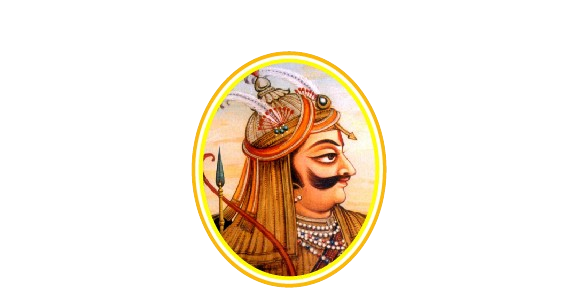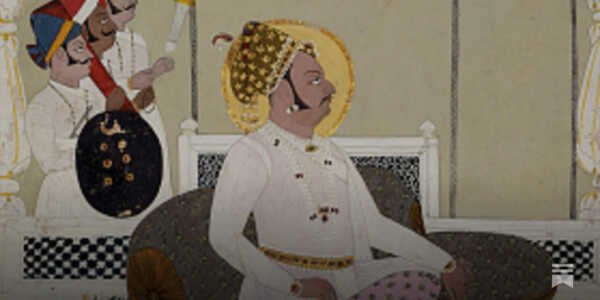A lot of work has been done in the last few decades on the history of Rajasthani miniature painting, which gives us knowledge not only about the development of miniature painting but also about the history of Rajasthan.
There is a great controversy about Rajput Painting’s origin, development, characteristic features and relationship with Mughal painting. The earliest evidence of Rajasthani painting belongs to the close of the 13th century in the form of book illustration found in the Suvaga Parikamna Sutta Chun,[1] a Jain scripture illustrated in Mewar during the reign of Maharawal Tej Singh.
Subsequently another Jain scripture Supasana Chariam[2] was illustrated in the first quarter of the 15th century, in the same tradition, in Mewar during the reign at Rana Mokal. Thus the earliest school of Rajasthani painting seems to have originated in Mewar. The choice of the subject matter as well as the chief features of the painting clearly suggest the influence [3] of western Indian or Jain school of painting.
The depiction of landscape [4] or natural objects in these paintings is in conventionalized and unrealistic form. The skyline horizon and skies are absent. The land and soil are flatly treated Trees and plants are decorative with tender and sinuous trunks, while their tops are oval in shape, on which clusters of leaves and flowers are painted.
Floral sprays are also shown in the foreground. Animals, birds, and insects are stylized. The humming bees appear many times in the landscape in keeping with the poetic description of the spring. Similarly peacocks get a privileged position as an object of beauty. The depiction of architecture is restricted, formal and without details.[5]
Thus, as a whole, both the plan and composition, the paintings present adlat appearance and show an unrealistic and unnatural landscape. These features of the landscape are further enhanced by the use of dark colours, uniform light effect and the two-dimensional effect of the natural objects. This type of landscape continues down to the beginning of the 16th century.
In the first half of the 16th century, new schools of Rajasthani painting were established at Chawand, Udaipur, Pali, Bikaner, Jodhpur, Amber, Bundi and Jaisalmer. They are in the tradition of the Mewar school, but with their local individual characteristics. During this period a large number of MSS. [6] were illustrated e.g. Chaur Panchasika, Laur Chanda, Gita Govinda, Rasikpriya, Bhagvat Purana, Baramasa, and the Ragmala series at all these places.
The characteristic features of the landscape of these paintings [7] are the division of plan and composition of the painting into compartments (either two or three) where each compartment keeps its separate identity. As a convention the painting was set in one colour pattern usually the dark blue, black, red or purple. The architectural setting in formative and without details.
However, the paintings of this period display a special emphasis on background and foreground. The background is marked by a small band of horizon on the upper margin of the painting usually covering 1/10th or 1/12th of the total length of the painting. The sky is depicted with a light black colour while the clouds are chain shaped patches of dark black colour. To bring emphasis strokes of lightning of snaky type usually in red colour are also shown in the sky.[8]
The foreground based on water with lotus flowers making a margin with the help of straight or wary line,[9] also developed as a special feature of these paintings. But the trees and plants retained the earlier conventionalized and decorative froms. However, the animals and birds are depicted more naturalistically and display some liveliness.
But the setting of all natural objects was suggestive rather than naturalistic due to the literary contexts of the themes. Therefore, the suggestive landscape resulted in an unrealistic and unnatural form of the painting. Similarly the uniform light effect and flat treatment of the different objects of nature further intensified the unrealistic depiction of the landscape.
The newly developed characteristic features of Rajasthani painting continued till the first half of the 17th century, with local variations in dress and archietcture depicted at the different centres. However, during this period the plan and composition of the painting altered.
The depiction of a well defined horizon with sky, clouds, lightening foreground with water full of lotus flowers, fish and aquatic birds; representation of animals and birds in larger number in a more naturalistic form but according to conventionalized pattern; architecture more elaborate with details and decoration, covering a substantial area of the whole composition of the painting were the new features [10] of the landscape of this period. But all these features retained their individuality and seem to have been unaffected by other contemporary schools of painting.
But the painting of the second half of the 17th century suggests a drastic change in the depiction of landscape, though the subject matter remains almost the same, i-e. Ragmala Series, Nayak Nayika bhedas, Ramayana, Mahabharata, Krishna Lila, Gita Govinda, Rasikpriya, Dhola Maru Ra Duha etc. with scenes depicting the court life.
Most notably, the depiction of the landscape [11] change considerably obviously due to the influence of the Imperial Court.[12] The absence of number of older features, suchas dark colours, uniform light effect, compartmentalisation of the composition, flat treatment, linear perspective, decorative trees and plants, marks a complete break with the earlier depictions of landscape in the Rajasthani schools.
The painting of this period were executed with a well defined background, foreground and a naturalistic skyline. The use of light colours, use of light and shade were radically new features. The depiction of foreground with tanks and fountains retaining the feature of lotus flowers and acquatic birds now become popular.
The undulations of the ground are also observable. The architectural background displays a combination of trabeate and arcuate styles, and attention is paid to details. The depiction of trees and plants is naturalistic, and the former conventionalized forms of trees and plants with oval shaped foliage and the crowding of blossoms are discarded. But the animals and birds retained their old naturalistic forms.
These changes enabled the artist to realise the aerial perspective and three dimensional effect in the landscape, though many of the characteristic features of the older Rajasthani school were still retained.
It would thus seem that the influence of Mughal court painting began to exercise a decisive effect on Rajasthani painting in relation to landscape, from the middle of the 17th century.
REFERENCES
[1] A. Skira, Paintings of India, p. 9.
[2] Moti Chandra, Studies in Early Indian Painting, p. 63; A. Skira,Painting of India, p. 62; Somani, Maharana Kumbha, pp. 298, 299; Rajasthan Mein Chitrakala ka-Kramik Vikas, Satya prakash, Cf. Raj. Bharti, V. 8, No. 1, 2, pp. 13, 14
[3] B. Gray, Rajput Painting, p. 2; A. Skira, Painting of India, p. 54; Philip p Rawson, Indian Painting, p. 88; H. Goetz, Art and Architecture of Bikaner State, p. 97; V.A. Smith, History of Fine Arts of India and Ceylon, p. 204.
[4] Moti Chandra, Studies in Early Indian Painting, p. 62; cf. Fig. 29; L. Hajek Miniatures From the East, p. 50; W.G. Archer, Indian Miniature, pp. 3, 4.
[5] Dr. Jagat Vir Singh Agre, Depiction of Landscape in Rajasthani Miniature Painting (XIII-XVII Century), Proceedings of Rajasthan History Congress, 1976, pp. 58-61.
[6] B. Gray, Rajput Painting, pp. 4, 5; S.E. Lee, Rajput Painting, pp. 14, 18; A. Skira, Painting of India p. 53; Miniature Paintings (Motichand Khajanchi Collection) Karl Khandalwala & others, pp. 14, 15; Moti Chandra, Studies in Early Indian Painting, p. 110; Chhabi, Bharat Kala Bhavan, p. 154.
[7] A. Coomara Swamy, Rajput Painting, V. 2, pl. 1, 2, 3a, 3b, 4; B. Gray, Rajput Painting, pl. 3; W.G. Archer, Indian Miniature, pl. 37; Robert Reiff, Indian Miniatures, pl. I; Moti Chandra, Studies in Early Indian painting, Fig. 70
[8] Dr. Jagat Vir Singh Agre, Depiction of Landscape in Rajasthani Miniature Painting (XIII-XVII Century), Proceedings of Rajasthan History Congress, 1976, pp. 58-61.
[9] Dr. A. Coomara Swamy holds zigzagged margin as a characteristic feature of Rajput painting, which is not correct of. Rajput Painting, V. I, p. 12. The same view is held by Dr. Moti Chandra, of. Studies in Early Indian Painting, p. 71.
[10] Miniature Painting, Karl Khandalwala & others. pl. C, E & Fig. 29, 30, 31, 34, 39, 55; Chhabi, Bharat Kala Bhavan; pl. D, E.; S.E. Lee, Rajput Painting, pls. 13, 14, 15; L. Hajek, Miniatures From the East, pl. 4, 6; W.G. Archer, Indian Miniature, pl. 38, 39, 40; Promod Chandra, Bundi Painting, Fig. 1; Moti Chandra, Mewar painting, pl. 1, 2, 3.
[11] A. Coomara Swamy, Rajput Painting, pl. 5, 6; W.G. Archer, Indian Miniatures, pl. 41, 42, 43; Moti Chandra, Mewar Painting, pl. 5, 6; Promod Chandra, Bundi Painting, pl. 1, 2, 3, 4; H. Goetz, Art & Architecture of Bikaner State, pl. 3, 6, 9, 78, 79; S.E. Lee, Rajput Painting, pl. 11, 16, 17b, 27, 28, 42, Chhabi, pl. L, M.N.
[12] Philip P. Rawson, Indian Painting, pp. 121, 137; Karl Khandalwala Miniature Paintings, p. 18.




